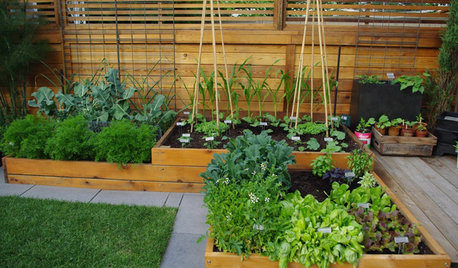Any experience with 'Soil Soup'?
JillH
20 years ago
Related Stories

GARDENING GUIDESGrow a Beautiful Garden in Alkaline Soil
Got alkaline soil? Learn how to manage it and the many beautiful plants that will thrive in this ‘sweet’ soil
Full Story
GARDENING GUIDESGardening Solutions for Heavy Clay Soils
What’s a gardener to do with soil that’s easily compacted and has poor drainage? Find out here
Full Story
FARM YOUR YARDHow to Get Good Soil for Your Edible Garden
The nutrients in your soil feed the plants that feed you. Here are tips on getting it right — just in time for planting season
Full Story
GARDENING GUIDESHow to Stop Worrying and Start Loving Clay Soil
Clay has many more benefits than you might imagine
Full Story
GARDENING GUIDESHave Acidic Soil in Your Yard? Learn to Love Gardening Anyway
Look to acid-loving plants, like conifers and rhododendrons, to help your low-pH garden thrive
Full Story
GARDENING GUIDESInvite Cellophane Bees to Your Garden by Providing Patches of Bare Soil
Look for cellophane bees (Colletes) pollinating flowering trees and shrubs in U.S. gardens this spring
Full Story
GARDENING GUIDESHouzz TV: Make a Worm Bin for Rich Soil and Happy Plants
A worm-powered compost bin that can fit under a sink turns food scraps into a powerful amendment for your garden. Here’s how to make one
Full Story
URBAN GARDENSExperiments Aplenty Fill Vancouver Edible Garden
Lush and brimming with test landscape plantings, a Canadian garden appeals to the eye and the palate
Full Story
GARDENING GUIDES6 Wonderfully Easy Roses for Any Gardener
Look like an expert even if you're just starting out, with these low-maintenance gems of the rose world
Full Story
EDIBLE GARDENSNatural Ways to Get Rid of Weeds in Your Garden
Use these techniques to help prevent the spread of weeds and to learn about your soil
Full Story





trianglejohn
JillHOriginal Author
Related Professionals
Port Royal Landscape Architects & Landscape Designers · Concord Landscape Contractors · Clark Landscape Contractors · Columbine Landscape Contractors · Gallatin Landscape Contractors · Lebanon Landscape Contractors · Marlborough Landscape Contractors · Newberg Landscape Contractors · Richmond Landscape Contractors · San Antonio Landscape Contractors · South Lyon Landscape Contractors · Brooklyn Center Solar Energy Systems · Eastvale Solar Energy Systems · Palo Alto Solar Energy Systems · Laguna Woods Solar Energy Systemstrianglejohn
annebert
mid_tn_mama
david52 Zone 6
Demeter
robbins
SeniorBalloon
spartangardener
trianglejohn
flowermanoat
mycarbumps
wasabinsoy
larry_c
kissyfur
keith.s
Belgianpup